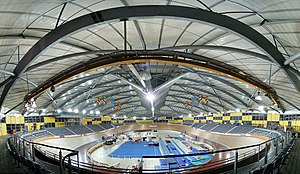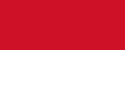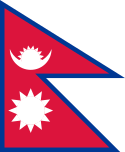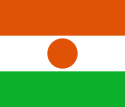Letnie Igrzyska Olimpijskie 2000
 | |
| Stolica igrzysk | |
|---|---|
| Liczba ekip | 199 |
| Liczba sportowców | ok. 10 651 |
| Liczba konkurencji | 300 w 31 dyscyplinach |
| Otwarcie | 15 września 2000 |
| Oficjalne otwarcie | William Deane (Gubernator Generalny Australii) |
| Zamknięcie | 1 października 2000 |
| Przysięga olimpijska | Rechelle Hawkes (sportowcy) |
| Znicz olimpijski | |
| Stadion | |
XXVII Letnie Igrzyska Olimpijskie (oficjalnie Igrzyska XXVII Olimpiady) odbyły się w 2000 roku w Sydney, w Australii.
Sydney zostało wybrane do tej roli 24 września 1993, kiedy to okazało się lepszym kandydatem od Pekinu, Berlina, Stambułu i Manchesteru[1]. W lipcu 1991 chęć organizacji igrzysk wyraził również Mediolan[2], ale w marcu 1993 wycofał swoją kandydaturę[3].
W igrzyskach wzięli udział przedstawiciele 199 państw, a cała impreza odbywała się w dniach 15 września – 1 października.
Prezydent MKOl Juan Antonio Samaranch triumfalnie oznajmił, że XXVII igrzyska były najwspanialszymi w historii imprezy, a potwierdzeniem tych słów miały być kolejne rekordy organizacyjne – rekordowa liczba krajów uczestniczących, sportowców, dyscyplin oraz konkurencji. Medale zdobyli reprezentanci 80 krajów.
W Sydney po raz pierwszy przeprowadzono rywalizację w taekwondo, triatlonie, w skokach synchronicznych do wody, a także po raz pierwszy wśród kobiet: w pięcioboju nowoczesnym, podnoszeniu ciężarów oraz w konkurencjach trampoliny (gimnastyka sportowa) i skoku o tyczce oraz rzucie młotem (lekkoatletyka). W australijskich igrzyskach zawodnicy 48-krotnie poprawiali lub wyrównywali rekordy świata.
Wyniki
Hasło
Dziel się duchem i miej odwagę marzyć (ang. Share The Spirit and Dare to Dream)
Obiekty olimpijskie
Obiekty wchodzące w skład Sydney Olimpic Park
- Stadium Australia – główna arena igrzysk, lekkoatletyka, piłka nożna (finał)
- Sydney International Aquatic Centre – skoki do wody, pływanie, pływanie synchroniczne, piłka wodna
- State Sports Centre – taekwondo, tenis stołowy
- NSW Tennis Centre – tenis ziemny
- Sydney Olympic Park Hockey Centre – hokej na trawie
- The Dome and Exhibition Complex – badminton, gimnastyka, koszykówka, siatkówka, pięciobój nowoczesny, piłka ręczna,
- Sydney SuperDome – gimnastyka artystyczna, skoki na trampolinie, koszykówka
- Sydney Baseball Stadium – baseball, pięciobój nowoczesny
- Sydney International Archery Park – łucznictwo
Obiekty znajdujące się w Sydney
- Sydney Convention and Exhibition Centre – boks, judo, szermierka, zapasy
- Sydney Entertainment Centre – siatkówka
- Dunc Gray Velodrome – kolarstwo torowe
- Sydney International Shooting Centre – strzelectwo
- Sydney International Equestrian Centre – jeździectwo
- Sydney International Regatta Centre – wioślarstwo, kajakarstwo
- Blacktown Olympic Centre – baseball, softball
- Mountain Bike Course, Fairfield City Farm – kolarstwo górskie
- Ryde Aquatic Leisure Centre – piłka wodna
- Penrith Whitewater Stadium – kajakarstwo górskie
- Bondi Beach – siatkówka plażowa
- Sydney Football Stadium – piłka nożna
- Woollahra Sailing Club – żeglarstwo
Obiekty znajdujące się poza Sydney
- Canberra Stadium – piłka nożna
- Hindmarsh Stadium – piłka nożna
- Melbourne Cricket Ground – piłka nożna
- Brisbane Cricket Ground – piłka nożna
Medale zdobyte przez Polaków
 Złote
Złote
- Robert Korzeniowski – chód na 20 km
- Robert Korzeniowski – chód na 50 km
- Renata Mauer-Różańska – strzelectwo
- Kamila Skolimowska – rzut młotem
- Szymon Ziółkowski – rzut młotem
- Tomasz Kucharski, Robert Sycz – wioślarstwo
 Srebrne
Srebrne
- Szymon Kołecki – podnoszenie ciężarów
- Agata Wróbel – podnoszenie ciężarów
- Paweł Baraszkiewicz, Daniel Jędraszko – kajakarstwo
- Krzysztof Kołomański, Michał Staniszewski – kajakarstwo górskie
- Sylwia Gruchała, Magdalena Mroczkiewicz, Anna Rybicka, Barbara Wolnicka – szermierka
 Brązowe
Brązowe
- Leszek Blanik – gimnastyka
- Aneta Pastuszka, Beata Sokołowska-Kulesza – kajakarstwo
- Dariusz Białkowski, Grzegorz Kotowicz, Adam Seroczyński, Marek Witkowski – kajakarstwo
Statystyka medalowa
W Sydney medale zdobyli zawodnicy z 80 krajów.
| Klasyfikacja medalowa | |||||
| Lp. | Państwo | złoto | srebro | brąz | razem |
|---|---|---|---|---|---|
| 1 | 36 | 24 | 32 | 92 | |
| 2 | 32 | 28 | 28 | 88 | |
| 3 | 28 | 16 | 14 | 58 | |
| 4 | 16 | 25 | 17 | 58 | |
| 5 | 13 | 17 | 26 | 56 | |
| 6 | 13 | 14 | 11 | 38 | |
| 7 | 13 | 8 | 13 | 34 | |
| 8 | 12 | 9 | 4 | 25 | |
| 9 | 11 | 11 | 7 | 29 | |
| 10 | 11 | 10 | 7 | 28 | |
| ... | ... | ... | ... | ... | ... |
| 14 | 6 | 5 | 3 | 14 | |
| Zobacz pełną klasyfikację medalową | |||||
Państwa biorące udział w igrzyskach
Po raz pierwszy na igrzyskach pojawiły się Erytrea, Mikronezja i Palau.
Jako oddzielna drużyna wystąpili sportowcy z Timoru Wschodniego, znajdującego się wówczas pod administracją ONZ.
Na start w igrzyskach, ze względu na dyskryminację kobiet, nie zezwolono rządzonemu przez talibów Afganistanowi.
| Europa | ||
|---|---|---|
| Ameryka Północna i Ameryka Południowa | ||
| Azja | ||
| Afryka | ||
| Australia i Oceania | ||
Varia
- Autorem projektu medalu Letnich Igrzysk Olimpijskich 2000 jest polski rzeźbiarz Wojciech Pietranik[4].
- Brązowe medale zostały wykonane z przetopionych monet wycofanych z obiegu[5].
Przypisy
- ↑ Alan Riding: OLYMPICS; 2000 Olympics Go to Sydney In Surprise Setback for China (ang.). nytimes.com, 1993-09-24. [dostęp 2017-12-25].
- ↑ Mediolan też kandyduje. „Głos Pomorza”, s. 7, 1991-07-11 (pol.).
- ↑ Milan Withdraws Olympic Bid (ang.). latimes.com, 1993-03-11. [dostęp 2017-12-25].
- ↑ Bardzo fajny kraj – Archiwum Rzeczpospolitej [dostęp 2014-08-17].
- ↑ Old coins for medals (ang.). nzherald.co.nz. [dostęp 2014-03-10].
Linki zewnętrzne
- Oficjalna strona Igrzysk [dostęp 2014-08-17]
Media użyte na tej stronie
Olympic Rings without "rims" (gaps between the rings), As used, eg. in the logos of the 2008 and 2016 Olympics. The colour scheme applied here pertains to the 2016 Olympics in Rio de Janeiro.
Olympic Rings without "rims" (gaps between the rings), As used, eg. in the logos of the 2008 and 2016 Olympics. The colour scheme applied here pertains to the 2016 Olympics in Rio de Janeiro.
Autor: https://phabricator.wikimedia.org/diffusion/GOJU/browse/master/AUTHORS.txt, Licencja: MIT
An icon from the OOjs UI MediaWiki lib.
Autor: https://phabricator.wikimedia.org/diffusion/GOJU/browse/master/AUTHORS.txt, Licencja: MIT
An icon from the OOjs UI MediaWiki lib.
Autor: B1mbo, Licencja: CC BY-SA 2.5
Drawing of a gold medal, based on Olympic rings.svg.
Autor: B1mbo, Licencja: CC BY-SA 2.5
Draw of a silver medal, based in Olympic rings.svg.
- The joining of the rings is not correct drawn.
Autor: B1mbo, Licencja: CC BY-SA 2.5
Drawing of a bronze medal, based on Olympic rings.svg.
The flag of Navassa Island is simply the United States flag. It does not have a "local" flag or "unofficial" flag; it is an uninhabited island. The version with a profile view was based on Flags of the World and as a fictional design has no status warranting a place on any Wiki. It was made up by a random person with no connection to the island, it has never flown on the island, and it has never received any sort of recognition or validation by any authority. The person quoted on that page has no authority to bestow a flag, "unofficial" or otherwise, on the island.
Flag of Albania
Flag of Belarus 1995-2012
Łatwo można dodać ramkę naokoło tej grafiki
Flaga Finlandii
Autor: Pedro A. Gracia Fajardo, escudo de Manual de Imagen Institucional de la Administración General del Estado, Licencja: CC0
Flaga Hiszpanii
Flag of Serbia and Montenegro, was adopted on 27 April 1992, as flag of Federal Republic of Yugoslavia (1992-2003).
Flag of Serbia and Montenegro, was adopted on 27 April 1992, as flag of Federal Republic of Yugoslavia (1992-2003).
Flag of Liechtenstein
Flag of Portugal, created by Columbano Bordalo Pinheiro (1857-1929), officially adopted by Portuguese government in June 30th 1911 (in use since about November 1910). Color shades matching the RGB values officially reccomended here. (PMS values should be used for direct ink or textile; CMYK for 4-color offset printing on paper; this is an image for screen display, RGB should be used.)
The flag of Aruba
Łatwo można dodać ramkę naokoło tej grafiki
Autor: See File history below for details., Licencja: CC0
The Flag of Dominica.
The flag of the Dominican Republic has a centered white cross that extends to the edges. This emblem is similar to the flag design and shows a bible, a cross of gold and 6 Dominican flags. There are branches of olive and palm around the shield and above on the ribbon is the motto "Dios,Patria!, Libertad" ("God, Country, Freedom") and to amiable freedom. The blue is said to stand for liberty, red for the fire and blood of the independence struggle and the white cross symbolized that God has not forgotten his people. "Republica Dominicana". The Dominican flag was designed by Juan Pablo Duarte, father of the national Independence of Dominican Republic. The first dominican flag was sewn by a young lady named Concepción Bona, who lived across the street of El Baluarte, monument where the patriots gathered to fight for the independence, the night of February 27th, 1844. Concepción Bona was helped by her first cousin María de Jesús Pina.
The national and official state flag of Haiti; arms obtained from http://www.webchantier.com/. The civil flag can be found at here.
Flag of Jamaica. “The sunshine, the land is green, and the people are strong and bold” is the symbolism of the colours of the flag. GOLD represents the natural wealth and beauty of sunlight; GREEN represents hope and agricultural resources; BLACK represents the strength and creativity of the people. The original symbolism, however, was "Hardships there are, but the land is green, and the sun shineth", where BLACK represented the hardships being faced.
State Flag of Venezuela 1930-2006, New flag was introduced 13 March 2006.
Flag of Georgia used from 1990 to 2004, with slightly different proportions than the 1918 to 1921 flag.
The Flag of India. The colours are saffron, white and green. The navy blue wheel in the center of the flag has a diameter approximately the width of the white band and is called Ashoka's Dharma Chakra, with 24 spokes (after Ashoka, the Great). Each spoke depicts one hour of the day, portraying the prevalence of righteousness all 24 hours of it.
bendera Indonesia
Flag of Israel. Shows a Magen David (“Shield of David”) between two stripes. The Shield of David is a traditional Jewish symbol. The stripes symbolize a Jewish prayer shawl (tallit).
Flag of Laos
Flag of Maldives. The colours used are Pantone 186 C for red and Pantone 348 C for green.
Łatwo można dodać ramkę naokoło tej grafiki
The national flag of Kingdom of Thailand since September 2017; there are total of 3 colours:
- Red represents the blood spilt to protect Thailand’s independence and often more simply described as representing the nation.
- White represents the religion of Buddhism, the predominant religion of the nation
- Blue represents the monarchy of the nation, which is recognised as the centre of Thai hearts.
Official flag used by the Fédération Internationale de Football Association (FIFA) to represent Chinese Taipei in association football matches. Also used at the Olympics from 1986 to 2010.
Olympic Movement flag
Proportions 2:3, created 1913, adopted 1914, first used 1920.
- Colors as per http://fairspielen.de/wp-content/uploads/2015/09/Annexe-3-Olympism_and_the_Olympic_Symbol_-_Principles_and_Usages_Guide-1.pdf
- blue: PMS 3005C
- yellow: PMS 137C
- black: PMS 426C
- green: PMS 355C
- red: PMS 192C
- Dimensions of the rings taken from http://fairspielen.de/wp-content/uploads/2015/09/Annexe-3-Olympism_and_the_Olympic_Symbol_-_Principles_and_Usages_Guide-1.pdf
The national flag of the Democratic Republic of the Congo. Created according to the 2006 constitution : Son emblème est le drapeau bleu ciel, orné d’une étoile jaune dans le coin supérieur gauche et traversé en biais d’une bande rouge finement encadrée de jaune. (Its symbol is a sky blue flag, decorated with a yellow star in the upper left corner and crossed in the diagonal by a red strip with thin yellow borders) It seems to be identical, except for a lighter field hue, to the 1966–1971 flag.
Flag of Namibia
The proportions of this flag are 3:2; however, there is no official definition for the correct proportions and also 5:3 is widely used.
Flag of Senegal
Flag of the Ivory Coast, written by Jon Harald Søby, modified by Zscout370. The colors match to what is reported at http://fotw.vexillum.com/flags/ci.html.
The flag of Guam, courtesy an e-mail from the author of xrmap. Modifications by Denelson83.
The national flag of Nauru. Official Pantone colours are: PMS 280 blue, PMS 123 yellow.
Flag of New Zealand. Specification: http://www.mch.govt.nz/nzflag/description.html , quoting New Zealand Gazette, 27 June 1902.
Flag of São Tomé and Príncipe
Autor: Cflm001 (talk), Licencja: CC-BY-SA-3.0
Countries which participated in the 2000 Summer Olympics, as listed at the olympic games museum, derived from blank world map.
- Blue = Participating for the first time
- Green = Have previously participated.
- Yellow square is host city (Sydney).
Made by author of Xramp, first uploaded by Denelson83 as Flag of Ecuador.svg, modifications by Husunqu.
Flag of South Korea from 21 February 1984 to October 1997, when the exact colors were specified into their shades. Sources: https://www.britannica.com/topic/flag-of-South-Korea, http://www.christusrex.org/www3/fotw/flags/kr_hist.html, http://fotw.fivestarflags.com/kr_hist.html, http://destinationsouthkorea.weebly.com/flag-history.html http://www.law.go.kr/lsInfoP.do?lsiSeq=51832&ancYd=19840221&ancNo=11361&efYd=19840221&nwJoYnInfo=N&efGubun=Y&chrClsCd=010202#0000.
Autor: Adam.J.W.C., Licencja: CC BY 3.0
Olympic Stadium Sydney. I had to upload this again. There was another image on Wikipedia with the same name. Adam.J.W.C. 22:36, 5 March 2008 (UTC)
Belize Flag before August 28, 2019 Standardzations SVG from 3 September 2019 revision by FDRMRZUSA
(c) Brian Pracy, CC BY-SA 3.0
Final of the women’s long jump competition at the 2000 Summer Olympics in Sydney
Autor: Adam.J.W.C., Licencja: CC BY 3.0
en:Dunc Gray Velodrome in the City of Bankstown. This is a 32 photo stitch. The photo is of reasonable quality, you can see a few bad joins, but apart from that it's not bad for a 31-32 photo Join that has been slightly cropped. I could have included more of the roof but the joins showed to much in it.Adam.J.W.C. 00:31, 4 March 2008 (UTC)
This is the flag of Bahrain used from 1972 until 2002. The base image is from the 2002 CIA World Factbook (mirrored at UMSL). I have removed the border and recolored the red section according to Image:Flag of Bahrain.svg.
Flag of Ethiopia (1996-2009)
The former flag of Rwanda (1962-2001). Commonly refered to as the "R" flag.
Flag of Italy from 1946 to 2003, when exact colors were specified.
Please do not replace the simplified code by a version created with Inkscape or another vector graphics editor❗
Former version of the flag of Paraguay
Flag of Saint Lucia, 1979
The flag of the Comoros (1996-2001).
Flag of Lesotho 1987-2006
Former Iraqi flag, used from 1991 to 2004.
The flag of San Marino, before the 2011 standardization
Flag of Turkmenistan from 1992 to 1997, with different ratio and slightly different symbols.




















































































































































































































